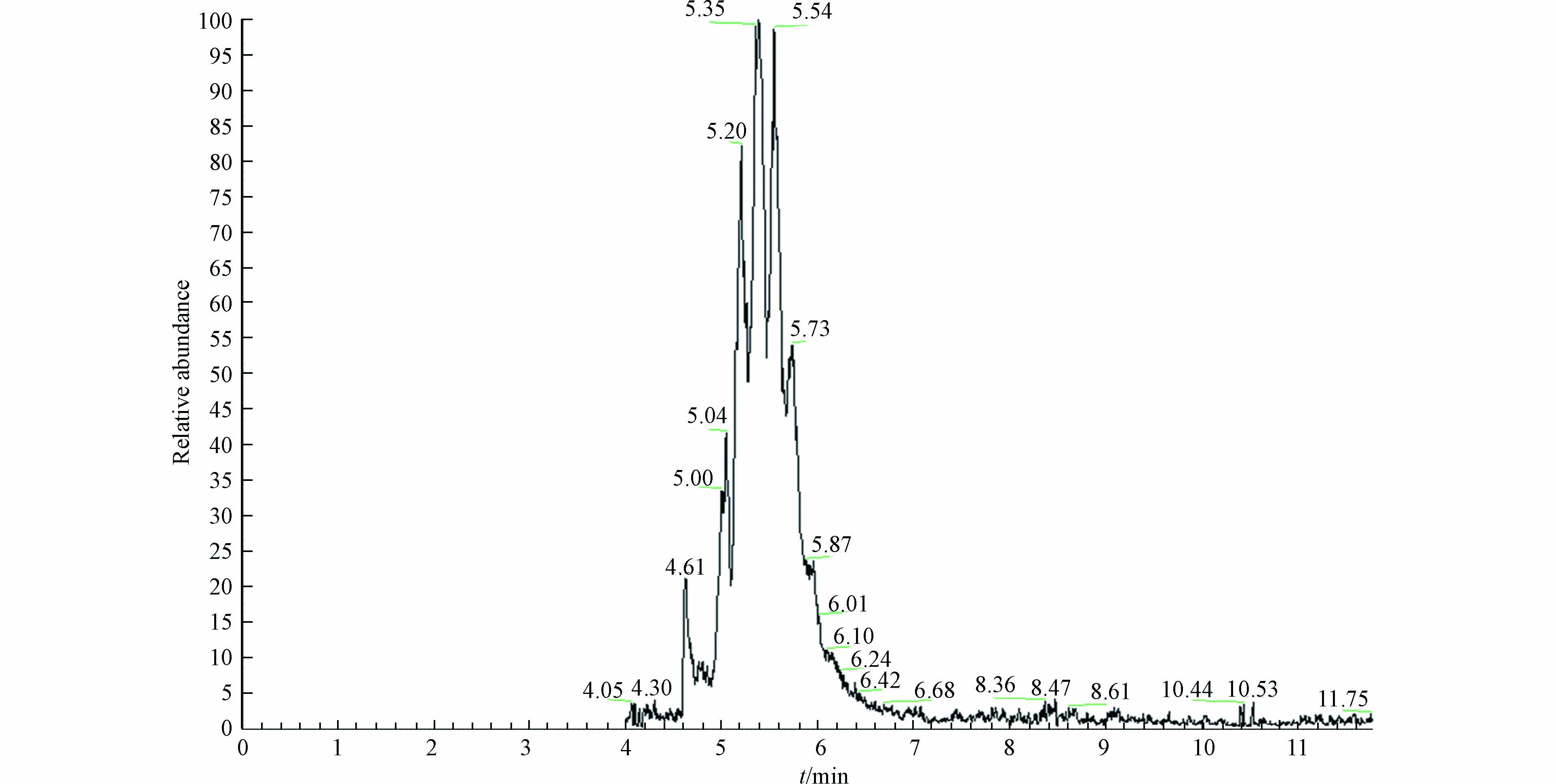-
短链氯化石蜡(short chain chlorinated paraffins,简称SCCPs)是一类含碳原子数为10—13的正构烷烃氯化衍生物,其分子式为CxH(2x-y+2)Cly(其中x=10—13,y=1—13),氯化程度范围为16%—78%。由于SCCPs具有挥发性低、阻燃性好、电绝缘性好及价格低廉等性能,常作为金属加工润滑剂、密封剂、阻燃剂、塑料添加剂等广泛应用于电缆电线、塑料、橡胶等生产。据统计,SCCPs在美洲和欧洲的年总产量为7.5—11.3千吨。而我国作为世界上最大的氯化石蜡生产国和出口国, 2009年氯化石蜡的产量已达100万吨,其中就包含大量的SCCP[1]。毒理学研究表明,SCCPs是一类具有持久性、远距离迁移性、生物蓄积性和生物毒性的物质,对生态环境和人类健康安全存在潜在的风险[2]。例如,SCCPs对啮齿动物、水生生物、鸟类等具有一定的毒性,会使其肝肾等器官发生病变,甚至导致某些生物的卵和胚胎发生畸形或死亡。Liu等[3]将斑马鱼胚胎暴露于SCCPs溶液培养一段时间后发现,斑马鱼胚胎出现存活率下降、发育异常、畸形等症状,且C10-SCCPs毒性高于C12-SCCPs。李勋等[4]将SD雄性小鼠暴露于两种SCCPs含量不同的氯化石蜡产品中,经口连续灌胃暴露14 d后,两种氯化石蜡都对大鼠具有一定的毒性,其肝脏、肾脏、肺部均出现明显损伤,且病变程度与暴露剂量有一定的剂量效应关系。目前,SCCPs已被《关于持久性有机污染物的斯德哥尔摩公约》列为持久性有机污染物(persistent organic pollutants,POPs)中新增的一类化合物,欧盟、美国、加拿大等陆续颁布有关条例,对SCCPs生产和使用进行限制或禁止。
目前,国内外关于SCCPs在日常消费品和人体样品的赋存特征已开展了一定研究,而相关的人体健康风险研究较少。有关研究表明,SCCPs已在儿童玩具、瑜伽垫、塑胶跑道、塑料供水管道甚至人体乳液中被广泛检出[5-8]。SCCPs常作为增塑剂、阻燃剂等功能助剂应用于纺织品生产,导致其在纺织产品中大量残留,进而通过皮肤接触等途径进入人体,并在体内蓄积,长期接触可能会对人体健康造成威胁。例如,儿童背包在生产过程中常加入SCCPs作为表面处理剂,而背包中SCCPs污染特征及其健康暴露风险尚未明晰。因此,了解目前背包中SCCPs的污染特征并研究及其对人体的健康风险有利于了解SCCPs这类新兴污染物在环境中的迁移规律和潜在风险。我国作为制造业大国,如背包类消费品具有巨大的生产量和消费量,研究其中如氯化石蜡类新兴污染物的暴露风险有利于促进制造行业的长期健康发展。 本研究采用气相色谱质谱联用法(GC-MS)测定不同背包样品中SCCPs含量,了解SCCPs污染与产品特性等因素之间的关系,并采用风险评估模型定量分析背包中SCCPs含量分别对成人和儿童的健康风险,研究结果可为我国制定SCCPs的相关标准和健康风险管理提供基础数据。
-
正己烷和二氯甲烷(Fisher Chemical)均为色谱级。SCCPs混标:氯含量分别为51.5%,55.5%,63%,100 ng·μL−1(Dr. Ehrenstorfer,德国),13C10-反式氯丹由美国CIL公司购买获得。仪器内标为六氯苯(AccuStandard,美国)。
-
所有背包样品均从网络渠道购买。使用干净的剪刀剪取适量的背包外皮,剪碎成约5 mm
× 5 mm的小块,使用冷冻研磨机研磨成粉末,置于干燥箱中保存。 -
往干净的玻璃离心管中加入100 ng 13C10-反式氯丹作为内标。将样品与10 mL正己烷/二氯甲烷(1∶1,V∶V)涡旋振荡1 min,超声提取20 min,然后以7000 r·min−1离心10 min,将上清液转移至新的玻璃离心管中,再重复提取2次,合并上清液。氮吹至近干,1 mL环己烷定容,进样前加入100 ng六氯苯作为进样内标。
本研究采用气相色谱联用仪(GC-MS,THERMO ISQ)进行SCCPs定性和定量分析,色谱柱为DB-5HT(15 m × 0.25 mm × 0.1 μm,固定相为5%苯基,95%二甲基聚硅氧烷)。进样口温度为280 ℃,进样模式为不分流进样,进样量1 μL;色谱升温程序为:初始温度100 ℃,保持1 min,然后以60 ℃·min−1程序升温至300 ℃,保持9 min。反应气为甲烷,流速为2.0 mL·min−1。离子源温度为160 ℃,扫描方式为SCAN(范围220—500 amu)。
本研究根据Reth的方法建立计算氯含量与响应因子的线性关系,实现SCCPs定量计算[9]。首先利用3种实际氯含量不同的SCCPs标准品按一定比例配制出9个实际氯含量不同的标准溶液。进样后根据公式(1)(2)计算出标准溶液总响应因子和实测氯含量:
由实测氯含量和总响应因子绘制标准曲线。本研究中配制标准溶液的实际氯含量为51.5%—63.0%,通过仪器分析得到计算氯含量为58.34%—63.10%。
实际样品中SCCPs进样后首先根据公式(2)得到计算氯含量,代入标准曲线后得到样品的总响应因子,根据公式(1)计算SCCPs的浓度。本方法线性相关系数(r2)为0.9757,检出限为5 mg·L−1,实际样品回收率在61.48%—157.96%之间。
-
实验中用到的所有玻璃仪器在使用前均经过7X洗液浸泡12h,洗净后用去离子水淋洗3次,在400 oC下烘烤4 h,冷却至室温备用。每 7个样品设置1个空白样,获取仪器检测状态。本研究分析过程严格按照美国国家环保局(USEPA)的QA/QC控制样监控:方法空白、加标空白、基质加标、基质加标平行样等,并用回收率指示物监测样品的制备和基质的影响。本研究回收率指示物为13C10-反式氯丹,其回收率在69.7%—131.9%之间。化合物的定量结果经回收率校正。
-
人体可通过呼吸吸入、皮肤接触、口腔摄入等途径接触环境中的SCCPs[10]。在背包使用过程中SCCPs主要通过皮肤接触进入人体,因此暴露途径主要为皮肤暴露。本论文借鉴前人SCCP皮肤暴露研究采用以下公式初步计算儿童和成人每日皮肤接触暴露量[10]:
式中,Ederm为经皮肤接触吸收的每日暴露量[μg·(kg·d)−1]; C为样品中SCCPs的含量(μg·g−1);SA为中国儿童和成人的皮肤接触表面积(m2);AF为皮肤黏附因子(g·m−2);ABS为吸附因子,通常取0.14,无单位[11];Et为每日暴露时间的百分比(t/24 h,%);BW为中国儿童和成人的体重(平均体重,kg)。由于人体与背包接触和使用背包的行为具有较大不确定性,因此接触表面积和暴露时间也可能不同。本研究中的生态风险评价基于有限的资料和调研,SA采用人体与背包接触可能性最大的手掌面积计算(约为人体表面积的1%);儿童每日使用背包时间估算为平均每日上下学时间,成人每日使用时间估算为平均每日通勤时间;使用背包的皮肤暴露时间为接触频次乘以接触时间,粗略定义接触频次约为每小时10次,每次接触时长约为1 min。
目前可用于SCCPs的毒理数据有限,并且人体健康风险研究也较少,根据现有资料,使用以下模型计算SCCPs的健康风险[12]:
式中,HQ为危害商,表征污染物的致癌和非致癌风险;DEDt为污染物的每日总暴露量[μg·(kg·d)−1],在本研究中即Ederm;RfD为污染物的参考剂量[μg·(kg·d)−1],由于美国环保署目前没有给出SCCPs的RfD,本研究采用国际化学品安全方案(IPCS)建议的非致肿瘤效应日耐受剂量100 μg·(kg·d)−1和慢性致肿瘤效应日耐受剂量11 μg·(kg·d)−1 [13]。若HQ ≤ 1,风险较小或可忽略;若HQ > 1,存在致癌或非致癌风险。各暴露参数的参考值见表1。
-
图1为背包样品中SCCPs的总离子流色谱图。本试验采用分析方法线性相关系数(R2)为0.9757,检出限为5 mg·L−1,样品回收率在61.48%—157.96%之间。该方法可应用于样品中短链氯化石蜡的定性和定量分析,能满足测试分析要求。
-
表2列出了背包样品中SCCPs的含量。在29个样品中,SCCPs检出率为86.2%,最高检出质量百分比为14.83‰。欧盟委员会(EU) 2015/2030指令规定,允许生产、投放市场和使用含有SCCPs质量分数低于0.15%的物质或制剂[17]。在所有样品中,有13个样品SCCPs含量超过0.15%,其余样品均未超标,总超标率为44.83%。背包中SCCPs的含量与生产原料、工艺水平等有关。背包中SCCPs含量超标可能与厂家生产技术较落后,增塑剂、表面处理剂使用不合理等有关。因此,有关部门应该加强监管,不定时地进行抽检,对产品不合格的厂家提出整改,以降低背包中SCCPs的含量,从而降低其对人体健康的风险。
-
在29个背包样品中,仅有18个样品提供了材质等信息,详见表3。由表3可知,18个样品里料均采用聚酯纤维,面料有尼龙、聚酯纤维、合成革等不同材质。其中里料为聚酯纤维,面料为聚酯纤维+PU/EVA的样品SCCPs的检出浓度最高为14.83‰,里料和面料均为聚酯纤维的背包样品J5检出浓度最低,仅为0.28‰。为进一步研究不同材质对SCCPs含量和检出浓度的影响,本论文根据背包面料进行了分类,详见表4。表4同时给出了不同面料材质背包检出SCCPs平均含量。由表4可知,材质为“人造革+聚酯纤维”的SCCPs平均含量最低,为0.06%,而采用其他材质的背包样品中SCCPs平均含量均较高,均超过欧盟委员会(EU) 2015/2030指令规定的允许浓度(即0.15%),这说明采用里料为聚酯纤维,面料为人造革的背包样品SCCPs的使用风险可能更低。
-
本研究选择背包样本中SCCPs的最大浓度、中位数浓度和平均浓度进行计算,结果粗略估计儿童和成人SCCPs每日的最高暴露剂量、中位剂量和平均暴露剂量。背包样品中SCCPs的最大浓度、中位数浓度和平均浓度为14833、1505、2987 µg·g−1,其健康风险评价见表5。儿童和成人经皮肤接触吸收SCCPs的每日暴露量分别在0.78×10−3—7.70×10−3 µg·(kg·d)−1和1.70×10−3—1.68×10−2 µg·(kg·d)−1之间。计算的非致癌风险熵和致癌风险熵结果都远远小于1,表明一般情况下背包中的SCCPs在本研究中的暴露途径下并不具有明显危害或致癌风险。
-
(1)本研究采用气相色谱质谱法测定背包样品中SCCPs的含量,样品总离子流色谱图与标准样品相似,线性方程为Y=1.34×106X-7.7×105,相关系数(R2)为0.9757,检出限为5 mg·L−1,实际样品回收率在61.48%—157.96%之间,可应用于样品中短链氯化石蜡的定性和定量分析,能满足测试分析要求。
(2)在所检29个背包样品中,SCCPs的检出率为86.2%,超标率为44.83%。这说明目前背包行业存在部分厂家的生产技术不合格等现象,有关部门应加强监管。不同材质的背包样品SCCPs的含量不同,其中,面料为人造革,里料为聚酯纤维的背包样品的SCCPs平均含量最低,未超过欧盟委员会(EU) 2015/2030指令规定的0.15%。其余材质的背包样品SCCPs平均含量均较高,均超过0.15%。
(3)儿童和成人经皮肤接触吸收SCCPs的每日暴露量分别在0.78×10−3—7.70×10−3 µg·(kg·d)−1和1.70×10−3—1.68×10−2 µg·(kg·d)−1之间,所有非致癌风险熵和致癌风险熵均小于1,说明背包样品中的SCCPs对成人和儿童的非致癌风险较小或可忽略。
背包中短链氯化石蜡污染特征分析及其健康风险评价
Pollution characteristic analysis and risk assessment of SCCPs in backpacks
-
摘要: 短链氯化石蜡(SCCPs)是一类含碳原子数为10—13的正构烷烃氯化衍生物,也是一类具有持久性、长距离迁移性、生物蓄积性和生物毒性的物质,对生态环境和人类健康安全存在潜在的风险。为了解市售背包中SCCPs的污染特征及健康风险,本文采用气相色谱-质谱联用法(GC-MS)测定29种常见品牌背包中SCCPs的含量,并采用健康风险评价模型初步评估背包中SCCPs对儿童和成人的健康风险。经检测,背包样品中SCCPs超标率为44.83%,检出率为86.2%。不同材质背包样本的SCCPs含量差异较大。其中,人造革为面料和聚酯纤维为里料的背包中SCCPs平均含量最低(0.06%),未超出(EU) 2015/2030指令规定的限值。风险结果表明,儿童和成人经皮肤接触吸收SCCPs的每日暴露量分别在0.78×10−3—7.70×10−3 µg·(kg·d)−1和1.70×10−3—1.68×10−2 µg·(kg·d)−1之间。不管是成人还是儿童,所有非致癌风险熵和致癌风险熵值均远远小于1,表明背包样中SCCPs对人体无明显健康风险。Abstract: Short-chain chlorinated paraffins (SCCPs) are a large and complex family of chlorinated n-alkanes with carbon chain lengths of 10—13. The environmental persistence, toxicity, bioaccumulation and long-range atmospheric transport of SCCPs, resulting in potential risk to the environment and human health. To study the pollution characteristics and health risk of SCCPs in backpacks, concentrations of SCCPs in 29 backpacks were measured by GC-MS in this study and health risk assessment models were used to assess the health risks of SCCPs in backpacks to children and adults. SCCPs were detected at a detection rate of 86.2%, and levels of SCCPs in 44.83% of the tested samples were found above the European Union regulation for SCCPs. The concentrations of SCCPs in backpacks made by different material or texture are quite different. Among them, the average concentration of SCCPs in backpack samples with artificial leather and polyester fiber is the lowest, which is 0.06% and not exceeding the regulation limit. The daily exposure of SCCPs for adults and children are 0.78×10−3—7.70×10−3 μg·(kg·d)−1 and 1.70×10−3—1.68×10−2 μg·(kg·d)−1, respectively. All non-carcinogenic risk entropy and carcinogenic risk entropy are less than 1, suggesting that the non-carcinogenic and carcinogenic risk of SCCPs in the backpack samples to the human body is low or negligible.
-
Key words:
- backpacks /
- short chain chlorinated paraffin (SCCPs) /
- concentration /
- risk assessment
-
短链氯化石蜡(short chain chlorinated paraffins,简称SCCPs)是一类含碳原子数为10—13的正构烷烃氯化衍生物,其分子式为CxH(2x-y+2)Cly(其中x=10—13,y=1—13),氯化程度范围为16%—78%。由于SCCPs具有挥发性低、阻燃性好、电绝缘性好及价格低廉等性能,常作为金属加工润滑剂、密封剂、阻燃剂、塑料添加剂等广泛应用于电缆电线、塑料、橡胶等生产。据统计,SCCPs在美洲和欧洲的年总产量为7.5—11.3千吨。而我国作为世界上最大的氯化石蜡生产国和出口国, 2009年氯化石蜡的产量已达100万吨,其中就包含大量的SCCP[1]。毒理学研究表明,SCCPs是一类具有持久性、远距离迁移性、生物蓄积性和生物毒性的物质,对生态环境和人类健康安全存在潜在的风险[2]。例如,SCCPs对啮齿动物、水生生物、鸟类等具有一定的毒性,会使其肝肾等器官发生病变,甚至导致某些生物的卵和胚胎发生畸形或死亡。Liu等[3]将斑马鱼胚胎暴露于SCCPs溶液培养一段时间后发现,斑马鱼胚胎出现存活率下降、发育异常、畸形等症状,且C10-SCCPs毒性高于C12-SCCPs。李勋等[4]将SD雄性小鼠暴露于两种SCCPs含量不同的氯化石蜡产品中,经口连续灌胃暴露14 d后,两种氯化石蜡都对大鼠具有一定的毒性,其肝脏、肾脏、肺部均出现明显损伤,且病变程度与暴露剂量有一定的剂量效应关系。目前,SCCPs已被《关于持久性有机污染物的斯德哥尔摩公约》列为持久性有机污染物(persistent organic pollutants,POPs)中新增的一类化合物,欧盟、美国、加拿大等陆续颁布有关条例,对SCCPs生产和使用进行限制或禁止。
目前,国内外关于SCCPs在日常消费品和人体样品的赋存特征已开展了一定研究,而相关的人体健康风险研究较少。有关研究表明,SCCPs已在儿童玩具、瑜伽垫、塑胶跑道、塑料供水管道甚至人体乳液中被广泛检出[5-8]。SCCPs常作为增塑剂、阻燃剂等功能助剂应用于纺织品生产,导致其在纺织产品中大量残留,进而通过皮肤接触等途径进入人体,并在体内蓄积,长期接触可能会对人体健康造成威胁。例如,儿童背包在生产过程中常加入SCCPs作为表面处理剂,而背包中SCCPs污染特征及其健康暴露风险尚未明晰。因此,了解目前背包中SCCPs的污染特征并研究及其对人体的健康风险有利于了解SCCPs这类新兴污染物在环境中的迁移规律和潜在风险。我国作为制造业大国,如背包类消费品具有巨大的生产量和消费量,研究其中如氯化石蜡类新兴污染物的暴露风险有利于促进制造行业的长期健康发展。 本研究采用气相色谱质谱联用法(GC-MS)测定不同背包样品中SCCPs含量,了解SCCPs污染与产品特性等因素之间的关系,并采用风险评估模型定量分析背包中SCCPs含量分别对成人和儿童的健康风险,研究结果可为我国制定SCCPs的相关标准和健康风险管理提供基础数据。
1. 材料与方法(Materials and Methods)
1.1 试剂和材料
正己烷和二氯甲烷(Fisher Chemical)均为色谱级。SCCPs混标:氯含量分别为51.5%,55.5%,63%,100 ng·μL−1(Dr. Ehrenstorfer,德国),13C10-反式氯丹由美国CIL公司购买获得。仪器内标为六氯苯(AccuStandard,美国)。
1.2 样品采集
所有背包样品均从网络渠道购买。使用干净的剪刀剪取适量的背包外皮,剪碎成约5 mm
× 1.3 提取和检测方法
往干净的玻璃离心管中加入100 ng 13C10-反式氯丹作为内标。将样品与10 mL正己烷/二氯甲烷(1∶1,V∶V)涡旋振荡1 min,超声提取20 min,然后以7000 r·min−1离心10 min,将上清液转移至新的玻璃离心管中,再重复提取2次,合并上清液。氮吹至近干,1 mL环己烷定容,进样前加入100 ng六氯苯作为进样内标。
本研究采用气相色谱联用仪(GC-MS,THERMO ISQ)进行SCCPs定性和定量分析,色谱柱为DB-5HT(15 m × 0.25 mm × 0.1 μm,固定相为5%苯基,95%二甲基聚硅氧烷)。进样口温度为280 ℃,进样模式为不分流进样,进样量1 μL;色谱升温程序为:初始温度100 ℃,保持1 min,然后以60 ℃·min−1程序升温至300 ℃,保持9 min。反应气为甲烷,流速为2.0 mL·min−1。离子源温度为160 ℃,扫描方式为SCAN(范围220—500 amu)。
本研究根据Reth的方法建立计算氯含量与响应因子的线性关系,实现SCCPs定量计算[9]。首先利用3种实际氯含量不同的SCCPs标准品按一定比例配制出9个实际氯含量不同的标准溶液。进样后根据公式(1)(2)计算出标准溶液总响应因子和实测氯含量:
总响应因子=相对总面积/标样浓度(1) (1) 实测氯含量=∑i相对积信号分i×理论氯含量i相对总面积 (2) 由实测氯含量和总响应因子绘制标准曲线。本研究中配制标准溶液的实际氯含量为51.5%—63.0%,通过仪器分析得到计算氯含量为58.34%—63.10%。
实际样品中SCCPs进样后首先根据公式(2)得到计算氯含量,代入标准曲线后得到样品的总响应因子,根据公式(1)计算SCCPs的浓度。本方法线性相关系数(r2)为0.9757,检出限为5 mg·L−1,实际样品回收率在61.48%—157.96%之间。
1.4 质量控制与质量保证(QA/QC)
实验中用到的所有玻璃仪器在使用前均经过7X洗液浸泡12h,洗净后用去离子水淋洗3次,在400 oC下烘烤4 h,冷却至室温备用。每 7个样品设置1个空白样,获取仪器检测状态。本研究分析过程严格按照美国国家环保局(USEPA)的QA/QC控制样监控:方法空白、加标空白、基质加标、基质加标平行样等,并用回收率指示物监测样品的制备和基质的影响。本研究回收率指示物为13C10-反式氯丹,其回收率在69.7%—131.9%之间。化合物的定量结果经回收率校正。
1.5 初步人体健康风险评价
人体可通过呼吸吸入、皮肤接触、口腔摄入等途径接触环境中的SCCPs[10]。在背包使用过程中SCCPs主要通过皮肤接触进入人体,因此暴露途径主要为皮肤暴露。本论文借鉴前人SCCP皮肤暴露研究采用以下公式初步计算儿童和成人每日皮肤接触暴露量[10]:
Ederm=(C×SA×AF×ABS×Et)/BW (3) 式中,Ederm为经皮肤接触吸收的每日暴露量[μg·(kg·d)−1]; C为样品中SCCPs的含量(μg·g−1);SA为中国儿童和成人的皮肤接触表面积(m2);AF为皮肤黏附因子(g·m−2);ABS为吸附因子,通常取0.14,无单位[11];Et为每日暴露时间的百分比(t/24 h,%);BW为中国儿童和成人的体重(平均体重,kg)。由于人体与背包接触和使用背包的行为具有较大不确定性,因此接触表面积和暴露时间也可能不同。本研究中的生态风险评价基于有限的资料和调研,SA采用人体与背包接触可能性最大的手掌面积计算(约为人体表面积的1%);儿童每日使用背包时间估算为平均每日上下学时间,成人每日使用时间估算为平均每日通勤时间;使用背包的皮肤暴露时间为接触频次乘以接触时间,粗略定义接触频次约为每小时10次,每次接触时长约为1 min。
目前可用于SCCPs的毒理数据有限,并且人体健康风险研究也较少,根据现有资料,使用以下模型计算SCCPs的健康风险[12]:
HQ=DEDt/RfD (4) 式中,HQ为危害商,表征污染物的致癌和非致癌风险;DEDt为污染物的每日总暴露量[μg·(kg·d)−1],在本研究中即Ederm;RfD为污染物的参考剂量[μg·(kg·d)−1],由于美国环保署目前没有给出SCCPs的RfD,本研究采用国际化学品安全方案(IPCS)建议的非致肿瘤效应日耐受剂量100 μg·(kg·d)−1和慢性致肿瘤效应日耐受剂量11 μg·(kg·d)−1 [13]。若HQ ≤ 1,风险较小或可忽略;若HQ > 1,存在致癌或非致癌风险。各暴露参数的参考值见表1。
表 1 人体健康风险评估参数值Table 1. Parameters used for human risk assessment modelling2. 结果与讨论(Results and discussion)
2.1 背包样品SCCPs含量分析
图1为背包样品中SCCPs的总离子流色谱图。本试验采用分析方法线性相关系数(R2)为0.9757,检出限为5 mg·L−1,样品回收率在61.48%—157.96%之间。该方法可应用于样品中短链氯化石蜡的定性和定量分析,能满足测试分析要求。
2.2 背包样品中SCCPs含量水平
表2列出了背包样品中SCCPs的含量。在29个样品中,SCCPs检出率为86.2%,最高检出质量百分比为14.83‰。欧盟委员会(EU) 2015/2030指令规定,允许生产、投放市场和使用含有SCCPs质量分数低于0.15%的物质或制剂[17]。在所有样品中,有13个样品SCCPs含量超过0.15%,其余样品均未超标,总超标率为44.83%。背包中SCCPs的含量与生产原料、工艺水平等有关。背包中SCCPs含量超标可能与厂家生产技术较落后,增塑剂、表面处理剂使用不合理等有关。因此,有关部门应该加强监管,不定时地进行抽检,对产品不合格的厂家提出整改,以降低背包中SCCPs的含量,从而降低其对人体健康的风险。
表 2 背包样品中SCCPs含量Table 2. Concentrations of SCCPs in schoolbag samples编号 No. 浓度/(mg·kg−1) Concentration SCCPs含量/‰ Mass ratio 是否超标 Over proof or not 1 2165 2.17 是 2 nd — 否 3 3263 3.26 是 4 3779 3.78 是 5 411 0.41 否 6 71 0.07 否 7 nd — 否 8 nd — 否 9 89 0.09 否 10 3017 3.012 是 11 9909 9.91 是 J1 7691 7.69 是 J2 2061 2.06 是 J3 450 0.45 否 J4 287 0.29 否 J5 275 0.28 否 J6 367 0.37 否 J7 1050 1.05 否 J8 834 0.83 否 J9 1648 1.65 是 J10 14,833 14.83 是 J11 9732 9.73 是 J12 1345 1.35 否 J13 1505 1.51 是 J14 980 0.98 否 J15 298 0.30 否 J16 10,768 10.77 是 J17 9,800 9.80 是 J18 nd — 否 1) nd,低于检出限。nd,below limit of detection. 2.3 不同材质中SCCPs的含量情况
在29个背包样品中,仅有18个样品提供了材质等信息,详见表3。由表3可知,18个样品里料均采用聚酯纤维,面料有尼龙、聚酯纤维、合成革等不同材质。其中里料为聚酯纤维,面料为聚酯纤维+PU/EVA的样品SCCPs的检出浓度最高为14.83‰,里料和面料均为聚酯纤维的背包样品J5检出浓度最低,仅为0.28‰。为进一步研究不同材质对SCCPs含量和检出浓度的影响,本论文根据背包面料进行了分类,详见表4。表4同时给出了不同面料材质背包检出SCCPs平均含量。由表4可知,材质为“人造革+聚酯纤维”的SCCPs平均含量最低,为0.06%,而采用其他材质的背包样品中SCCPs平均含量均较高,均超过欧盟委员会(EU) 2015/2030指令规定的允许浓度(即0.15%),这说明采用里料为聚酯纤维,面料为人造革的背包样品SCCPs的使用风险可能更低。
表 3 18个背包样品基本信息Table 3. Basic information of schoolbag samples编号No. 材质 Material SCCPs含量/‰ Mass ratio J1 面料:尼龙 里料:聚酯纤维 7.69 J2 面料:聚酯纤维 里料:聚酯纤维 2.06 J3 面料:聚酯纤维+EVA 里料:聚酯纤维 0.45 J4 面料:尼龙 里料:聚酯纤维 0.29 J5 面料:聚酯纤维 里料:聚酯纤维 0.28 J6 面料:PU合成革 里料:聚酯纤维 0.37 J7 面料:聚酯纤维+EVA+PU 里料:聚酯纤维 1.05 J8 面料:人造革 里料:聚酯纤维 0.83 J9 面料:聚酯纤维 里料:聚酯纤维 1.65 J10 面料:聚酯纤维+PU/EVA 里料:聚酯纤维 14.83 J11 面料:聚酯纤维+EVA 里料:聚酯纤维 9.73 J12 面料:聚酯纤维 里料:聚酯纤维 1.35 J13 面料:聚酯纤维 里料:聚酯纤维 1.51 J14 面料:聚酯纤维+PU/EVA 里料:聚酯纤维 0.98 J15 面料:聚酯纤维+PU/EVA 里料:聚酯纤维 0.30 J16 面料:聚酯纤维 里料:聚酯纤维 10.77 J17 面料:聚酯纤维+PU/EVA 里料:聚酯纤维 9.80 J18 面料:尼龙 里料:聚酯纤维 - 表 4 不同材质中SCCPs平均含量Table 4. The mean concentrations of SCCPs in different materials材质 Material 样本编号 Sample ID SCCPs平均含量/% Average mass ratio 面料:尼龙 里料:聚酯纤维 J1、J4、J18 0.40 面料:聚酯纤维 里料:聚酯纤维 J2 、J5 、J9、 J12 、J13 、J16 0.26 面料:聚酯纤维+EVA/PU 里料:聚酯纤维 J3、 J7 、J10 、J11、J14 、J15 、J17 0.53 面料:人造革 里料:聚酯纤维 J6、J8 0.06 2.4 背包样品中SCCPs的初步人体暴露风险评价
本研究选择背包样本中SCCPs的最大浓度、中位数浓度和平均浓度进行计算,结果粗略估计儿童和成人SCCPs每日的最高暴露剂量、中位剂量和平均暴露剂量。背包样品中SCCPs的最大浓度、中位数浓度和平均浓度为14833、1505、2987 µg·g−1,其健康风险评价见表5。儿童和成人经皮肤接触吸收SCCPs的每日暴露量分别在0.78×10−3—7.70×10−3 µg·(kg·d)−1和1.70×10−3—1.68×10−2 µg·(kg·d)−1之间。计算的非致癌风险熵和致癌风险熵结果都远远小于1,表明一般情况下背包中的SCCPs在本研究中的暴露途径下并不具有明显危害或致癌风险。
表 5 本研究中背包样品的健康风险评价结果Table 5. Results of health risk assessment of schoolbag samples used in this study人群People 数据类型Data type 暴露量/(μg·(kg·d)−1)Exposure 非致癌风险熵Non-neoplastic HQ 致癌风险熵Neoplastic HQ 最大值 7.70×10−3 7.7×10−5 7.0×10−4 儿童 中位数 0.78×10−3 7.8×10−6 7.1×10−5 平均值 1.55×10−3 1.6×10−5 1.4×10−4 最大值 1.68×10−2 1.7×10−4 1.5×10−3 成人 中位数 1.70×10−3 1.7×10−5 1.5×10−4 平均值 3.43×10−3 3.4×10−5 3.1×10−4 3. 结论(Conclusions)
(1)本研究采用气相色谱质谱法测定背包样品中SCCPs的含量,样品总离子流色谱图与标准样品相似,线性方程为Y=1.34×106X-7.7×105,相关系数(R2)为0.9757,检出限为5 mg·L−1,实际样品回收率在61.48%—157.96%之间,可应用于样品中短链氯化石蜡的定性和定量分析,能满足测试分析要求。
(2)在所检29个背包样品中,SCCPs的检出率为86.2%,超标率为44.83%。这说明目前背包行业存在部分厂家的生产技术不合格等现象,有关部门应加强监管。不同材质的背包样品SCCPs的含量不同,其中,面料为人造革,里料为聚酯纤维的背包样品的SCCPs平均含量最低,未超过欧盟委员会(EU) 2015/2030指令规定的0.15%。其余材质的背包样品SCCPs平均含量均较高,均超过0.15%。
(3)儿童和成人经皮肤接触吸收SCCPs的每日暴露量分别在0.78×10−3—7.70×10−3 µg·(kg·d)−1和1.70×10−3—1.68×10−2 µg·(kg·d)−1之间,所有非致癌风险熵和致癌风险熵均小于1,说明背包样品中的SCCPs对成人和儿童的非致癌风险较小或可忽略。
-
表 1 人体健康风险评估参数值
Table 1. Parameters used for human risk assessment modelling
表 2 背包样品中SCCPs含量
Table 2. Concentrations of SCCPs in schoolbag samples
编号 No. 浓度/(mg·kg−1) Concentration SCCPs含量/‰ Mass ratio 是否超标 Over proof or not 1 2165 2.17 是 2 nd — 否 3 3263 3.26 是 4 3779 3.78 是 5 411 0.41 否 6 71 0.07 否 7 nd — 否 8 nd — 否 9 89 0.09 否 10 3017 3.012 是 11 9909 9.91 是 J1 7691 7.69 是 J2 2061 2.06 是 J3 450 0.45 否 J4 287 0.29 否 J5 275 0.28 否 J6 367 0.37 否 J7 1050 1.05 否 J8 834 0.83 否 J9 1648 1.65 是 J10 14,833 14.83 是 J11 9732 9.73 是 J12 1345 1.35 否 J13 1505 1.51 是 J14 980 0.98 否 J15 298 0.30 否 J16 10,768 10.77 是 J17 9,800 9.80 是 J18 nd — 否 1) nd,低于检出限。nd,below limit of detection. 表 3 18个背包样品基本信息
Table 3. Basic information of schoolbag samples
编号No. 材质 Material SCCPs含量/‰ Mass ratio J1 面料:尼龙 里料:聚酯纤维 7.69 J2 面料:聚酯纤维 里料:聚酯纤维 2.06 J3 面料:聚酯纤维+EVA 里料:聚酯纤维 0.45 J4 面料:尼龙 里料:聚酯纤维 0.29 J5 面料:聚酯纤维 里料:聚酯纤维 0.28 J6 面料:PU合成革 里料:聚酯纤维 0.37 J7 面料:聚酯纤维+EVA+PU 里料:聚酯纤维 1.05 J8 面料:人造革 里料:聚酯纤维 0.83 J9 面料:聚酯纤维 里料:聚酯纤维 1.65 J10 面料:聚酯纤维+PU/EVA 里料:聚酯纤维 14.83 J11 面料:聚酯纤维+EVA 里料:聚酯纤维 9.73 J12 面料:聚酯纤维 里料:聚酯纤维 1.35 J13 面料:聚酯纤维 里料:聚酯纤维 1.51 J14 面料:聚酯纤维+PU/EVA 里料:聚酯纤维 0.98 J15 面料:聚酯纤维+PU/EVA 里料:聚酯纤维 0.30 J16 面料:聚酯纤维 里料:聚酯纤维 10.77 J17 面料:聚酯纤维+PU/EVA 里料:聚酯纤维 9.80 J18 面料:尼龙 里料:聚酯纤维 - 表 4 不同材质中SCCPs平均含量
Table 4. The mean concentrations of SCCPs in different materials
材质 Material 样本编号 Sample ID SCCPs平均含量/% Average mass ratio 面料:尼龙 里料:聚酯纤维 J1、J4、J18 0.40 面料:聚酯纤维 里料:聚酯纤维 J2 、J5 、J9、 J12 、J13 、J16 0.26 面料:聚酯纤维+EVA/PU 里料:聚酯纤维 J3、 J7 、J10 、J11、J14 、J15 、J17 0.53 面料:人造革 里料:聚酯纤维 J6、J8 0.06 表 5 本研究中背包样品的健康风险评价结果
Table 5. Results of health risk assessment of schoolbag samples used in this study
人群People 数据类型Data type 暴露量/(μg·(kg·d)−1)Exposure 非致癌风险熵Non-neoplastic HQ 致癌风险熵Neoplastic HQ 最大值 7.70×10−3 7.7×10−5 7.0×10−4 儿童 中位数 0.78×10−3 7.8×10−6 7.1×10−5 平均值 1.55×10−3 1.6×10−5 1.4×10−4 最大值 1.68×10−2 1.7×10−4 1.5×10−3 成人 中位数 1.70×10−3 1.7×10−5 1.5×10−4 平均值 3.43×10−3 3.4×10−5 3.1×10−4 -
[1] 朱志保, 周琴, 赵远. 短链氯化石蜡的研究进展 [J]. 化工进展, 2015, 34(8): 3165-3172,3187. ZHU Z B, ZHOU Q, ZHAO Y. Research progress of short chain chlorinated paraffins [J]. Chemical Industry and Engineering Progress, 2015, 34(8): 3165-3172,3187(in Chinese).
[2] 杨立新, 刘印平, 王丽英, 等. 短链氯化石蜡毒性效应及检测技术研究进展 [J]. 食品安全质量检测学报, 2015, 6(10): 3795-3803. YANG L X, LIU Y P, WANG L Y, et al. Research advances on toxic effect and detection technology of short chain chlorinated paraffins [J]. Journal of Food Safety & Quality, 2015, 6(10): 3795-3803(in Chinese).
[3] LIU L H, LI Y F, COELHAN M, et al. Relative developmental toxicity of short-chain chlorinated paraffins in Zebrafish (Danio rerio) embryos [J]. Environmental Pollution, 2016, 219: 1122-1130. doi: 10.1016/j.envpol.2016.09.016 [4] 李勋, 刘钰晨, 陈敏杰, 等. 短链氯化石蜡急性暴露对SD雄性大鼠的组织病理学影响 [J]. 江汉大学学报(自然科学版), 2013, 41(5): 20-25. LI X, LIU Y C, CHEN M J, et al. Influence on rats' histopathology under exposing of short chain chlorinated paraffins [J]. Journal of Jianghan University (Natural Science Edition), 2013, 41(5): 20-25(in Chinese).
[5] 林伟. 塑料供水管道中短链氯化石蜡检测技术研究 [J]. 塑料工业, 2016, 44(9): 103-105,111. doi: 10.3969/j.issn.1005-5770.2016.09.025 LIN W. Study on the detection techniques of short chain chlorinated paraffins in plastic water supply pipe [J]. China Plastics Industry, 2016, 44(9): 103-105,111(in Chinese). doi: 10.3969/j.issn.1005-5770.2016.09.025
[6] 李玉娟. 短链氯化石蜡于不同合成材料运动场地中的检出研究 [J]. 化工管理, 2017(21): 45. doi: 10.3969/j.issn.1008-4800.2017.21.041 LI Y J. Study on the detection of short-chain chlorinated paraffin in different synthetic material sports grounds [J]. Chemical Enterprise Management, 2017(21): 45(in Chinese). doi: 10.3969/j.issn.1008-4800.2017.21.041
[7] 于智睿, 陈振玲, 李晶, 等. 塑料玩具中短链氯化石蜡含量检测 [J]. 中国塑料, 2019, 33(8): 95-100. YU Z R, CHEN Z L, LI J, et al. Determination of short chain-chlorinated paraffin in plastic toys [J]. China Plastics, 2019, 33(8): 95-100(in Chinese).
[8] THOMAS G O, FARRAR D, BRAEKEVELT E, et al. Short and medium chain length chlorinated paraffins in UK human milk fat [J]. Environment International, 2006, 32(1): 34-40. doi: 10.1016/j.envint.2005.04.006 [9] RETH M, ZENCAK Z, OEHME M. New quantification procedure for the analysis of chlorinated paraffins using electron capture negative ionization mass spectrometry [J]. Journal of Chromatography A, 2005, 1081(2): 225-231. doi: 10.1016/j.chroma.2005.05.061 [10] WANG P W, ZHAO N, CUI Y, et al. Short-chain chlorinated paraffin (SCCP) pollution from a CP production plant in China: Dispersion, congener patterns and health risk assessment [J]. Chemosphere, 2018, 211: 456-464. doi: 10.1016/j.chemosphere.2018.07.136 [11] WANG Y L, HU J X, LIN W, et al. Health risk assessment of migrant workers' exposure to polychlorinated biphenyls in air and dust in an e-waste recycling area in China: Indication for a new wealth gap in environmental rights [J]. Environment International, 2016, 87: 33-41. doi: 10.1016/j.envint.2015.11.009 [12] LIU L H, MA W L, LIU L Y, et al. Occurrence, sources and human exposure assessment of SCCPs in indoor dust of northeast China [J]. Environmental Pollution, 2017, 225: 232-243. doi: 10.1016/j.envpol.2017.03.008 [13] IPCS (International Programme on Chemical Safety), 1996. Chlorinated paraffins. World Health Organization, Geneva, 181 pp. (Environmental Health Criteria 181). [14] 李如忠, 周爱佳, 童芳, 等. 合肥市城区地表灰尘重金属分布特征及环境健康风险评价 [J]. 环境科学, 2011, 32(9): 2661-2668. LI R Z, ZHOU A J, TONG F, et al. Distribution of metals in urban dusts of Hefei and health risk assessment [J]. Environmental Science, 2011, 32(9): 2661-2668(in Chinese).
[15] 刘爱玲, 李艳平, 崔朝辉, 等. 我国中小学生学习日平均活动时间分析 [J]. 中国学校卫生, 2006, 27(6): 473-475. doi: 10.3969/j.issn.1000-9817.2006.06.013 LIU A L, LI Y P, CUI Z H, et al. Analysis on average time of physical activity in a school day among Chinese students [J]. Chinese Journal of School Health, 2006, 27(6): 473-475(in Chinese). doi: 10.3969/j.issn.1000-9817.2006.06.013
[16] 住房和城乡建设部. 2020年度全国主要城市通勤监测报告 [R]. 2020. Ministry of Housing and Urban-Rural Development. Commuting Monitoring Report of Major Cities in China in 2020 [R]. 2020 (in Chinese).
[17] 田恺, 于智睿, 于燕燕. 儿童玩具中短链氯化石蜡检测研究进展 [J]. 离子交换与吸附, 2016, 32(2): 185-192. TIAN K, YU Z R, YU Y Y. Research progress of detection of short-chain chlorinated PARAFFINS(SCCPs) in plastic toys [J]. Ion Exchange and Adsorption, 2016, 32(2): 185-192(in Chinese).
-





 DownLoad:
DownLoad:



